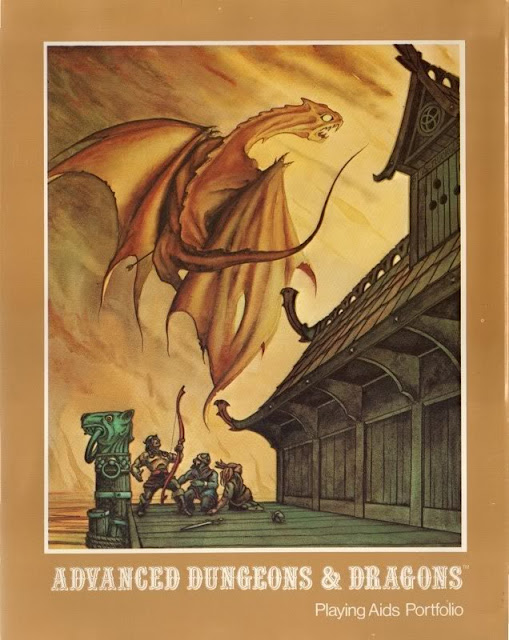Artist Alex Nuckols made what disappointingly ended up being a minor yet still evocative contribution to the visual history of D&D with a series of paintings he was commissioned to produce for a school supply company named St. Regis. It seems he painted nearly a dozen pieces that graced the covers of D&D-themed notebooks, folders, and three-ring binders in 1980-81. As a D&D-obsessed kid of 10-11 years old at the time, I owned three or four of these and have never parted with them.
Here are some examples I found online. I’ve always regretted that Nuckols didn’t produce work for any actual gaming material released by TSR (or any game company) because to this day I think he captured the gritty feel and texture of how I imagined these fantasy worlds in my mind’s eye. He was certainly a more accomplished artist than many of those who ended up in the stable as staff at TSR at the time. Artistically, his compositions are always compelling and typically eschew the over-heroic poses of much fantasy art. The moments he chooses to depict are usually ones in which the “protagonists” are quite vulnerable, overwhelmed, and not at all certain of survival, with a genuine sense of pervasive fear as the “heroes” encounter something they might not be capable of reckoning with.
This looming dread and uncertainty was much more in the spirit of how our games of D&D felt at the table and how I imagined any good D&D narrative should feel. The less-than-heroic realism of the anatomy, garb, and proportions of the characters only added to the perilous realism depicted in a moody watercolor palette. I was hoping that the recent art of D&D book was going to at least reference this series of paintings, and was disappointed by their omission.
My career is in publishing, and besides my day job I also have my own press dedicated to preserving the forgotten work of illustrators and cartoonists. If anybody has any of these notebooks and folders and would be willing to make high-resolution scans, I very much would like to publish a portfolio of these underappreciated gems.
If you enjoyed this post, you may want to check out the subsequent installments in the "Lost Art of D&D" series of posts.





Great art! I didnt see these untill they popped up on ebay recently.
ReplyDeleteIs he related to Harry W. Nuckols, author of B9 Castle Caldwell (and apparently not a pun)
No he's not. He was the son of Dr. Frank J. Nuckols of Birmingham, Al
DeleteI have a very beat up version of the opening shot.
ReplyDeleteWonderful images! The essence of (pre super-heroic) D&D. Thanks for sharing these.
ReplyDeleteI poked around a bit, and found this thread on an art site. Scroll down to where his nephew joins the conversation. Sadly, Nuckols passed away in 2008. But, perhaps, contact his nephew to see about reprinting his work? I'd love to see such a book (or even retro folders).
ReplyDeletehttp://www.artconversation.com/forum/questions/12341-alex-nuckols-print-1973
I had two of these folders and, I think, still do (though they are very beaten). One is the guy with an axe above, the other (not pictured) shows a sorcerous-looking individual with a dagger.
ReplyDeleteWould love a collections of these.
Well written and agree with your take on the art completely.
ReplyDelete